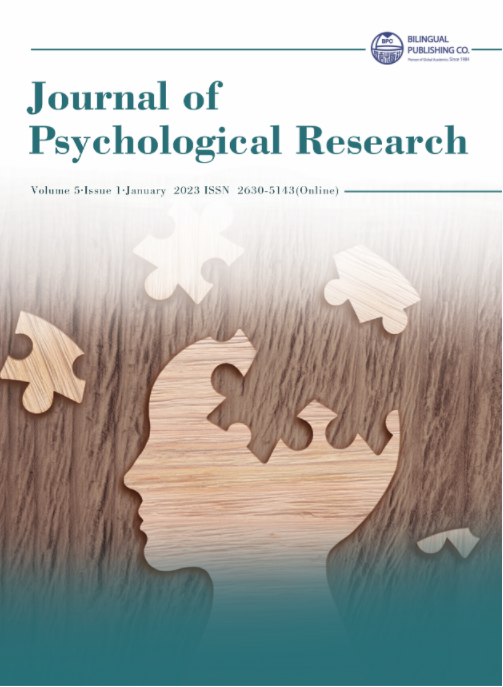-
568
-
343
-
332
-
311
-
281
The Powerful Role of Mothers in Adolescent Purpose Development
DOI:
https://doi.org/10.30564/jpr.v5i1.5236Abstract
Adolescence is a critical time for the cultivation of life purpose, also known as a meaningful long-term aim focused on contribution to others. Youth with purpose, especially marginalized youth, report a number of positive outcomes. Relationships with caring adults appear to be particularly helpful in guiding young people on their path to purpose, but little work has focused specifically on the role of mothers. This qualitative study, approved by a Institutional Review Board, examines how twenty adolescents from marginalized communities describe their sense of purpose and its relationship to their caregivers. The sample size was determined based on saturation, a process in qualitative research when the researchers begin to observe redundancy in the data. Through content analysis, a major theme emerged: the role of mothers and their impact on purpose development on their children. Results showed that mothers helped their adolescents develop their sense of purpose through serving as a sense of inspiration, providing the adolescents with support, sparking a desire for the adolescents to make their mothers proud, and through the mothers and adolescents in engaging in conversations about one’s future.
Keywords:
Adolescents; Positive youth development; Purpose; Marginalized youth; MothersReferences
[1] Gutowski, E., White, A.E., Liang, B., et al., 2018. How stress influences purpose develop-ment: The importance of social support. Journal of Adolescent Research. 33(5), 571-597.
[2] Hankin, B.L., Mermelstein, R., Roesch, L., 2007. Sex differences in adolescent depression: Stress exposure and reactivity models. Child Development. 78(1), 279-295.
[3] Erikson, E.H., 1968. Identity: Youth and crisis (No. 7). WW Norton & Company: New York.
[4] Blattner, M.C., Liang, B., Lund, T., et al., 2013. Searching for a sense of purpose: The role of parents and effects on self-esteem among female adolescents. Journal of Adolescence. 36(5), 839-848.
[5] Bronk, K.C., Finch, W.H., 2010. Adolescent characteristics by type of long-term aim in life. Applied Developmental Science. 14(1), 35-44.
[6] Damon, W., 2008. Moral child: Nurturing chil-dren’s natural moral growth. Free Press: USA.
[7] Damon, W., Menon, J., Cotton Bronk, K., 2003. The development of purpose during adoles-cence. Applied Developmental Science. 7(3), 119-128.
[8] Hill, P.L., Burrow, A.L., O’Dell, A.C., et al., 2010. Classifying adolescents’ conceptions of purpose in life. The Journal of Positive Psychol-ogy. 5(6), 466-473.
[9] Kashdan, T.B., McKnight, P.E., 2013. Com-mitment to a purpose in life: An antidote to the suffering by individuals with social anxiety dis-order. Emotion. 13(6), 1150.
[10] Liang, B., Lund, T., Mousseau, A., et al., 2018. Adolescent girls finding purpose: The role of parents and prosociality. Youth & Society. 50(6), 801-817.
[11] Spencer, R., Walsh, J., Liang, B., et al., 2018. Having it all? A qualitative examination of af-fluent adolescent girls’ perceptions of stress and their quests for success. Journal of Adolescent Research. 33(1), 3-33.
[12] Liang, B., White, A., Mousseau, A.M.D., et al., 2017. The four P’s of purpose among college bound students: People, propensity, passion, prosocial benefits. The Journal of Positive Psy-chology. 12(3), 281-294.
[13] Liang, B., Lund, T.J., Mousseau, A.M.D., et al., 2016. The mediating role of engagement in mentoring relationships and self-esteem among affluent adolescent girls. Psychology in the Schools. 53(8), 848-860.
[14] Sumner, R., Burrow, A.L., Hill, P.L., 2018. The development of purpose in life among adoles-cents who experience marginalization: Potential opportunities and obstacles. American Psychol-ogist. 73(6), 740.
[15] Moran, S., Bundick, M., Malin, H., et al., 2013. How supportive of their specific purposes do youth believe their family and friends are? Jour-nal of Adolescent Research. 28(3), 348-377.
[16] Massey, E.K., Gebhardt, W.A., Garnefski, N., 2008. Adolescent goal content and pursuit. A review of the literature from the past 16 years. Developmental Review. 18, 421-460.
[17] Bronk, K.C., 2012. A grounded theory of the development of noble youth purpose. Journal of Adolescent Research. 27(1), 78-109.
[18] Malin, H., Reilly, T.S., Quinn, B., et al., 2014. Adolescent purpose development: Exploring empathy, discovering roles, shifting priorities, and creating pathways. Journal of Research on Adolescence. 24(1), 186-199.
[19] Kashdan, T.B., McKnight, P.E., 2009. Origins of purpose in life: Refining our understanding of a life well lived. Psychological Topics. 18, 303-316. doi: 316.6:159.922.2.
[20] Malin, H., Morton, E., Nadal, A., et al., 2019. Purpose and coping with adversity: A repeated measures, mixed-methods study with young ad-olescents. Journal of Adolescence. 76, 1-11.
[21] Bandura, A., 1977. Self-efficacy: Toward a uni-fying theory of behavioral change. Psychologi-cal Review. 84(2), 191.
[22] Hill, P.L., Burrow, A.L., Sumner, R., 2013. Ad-dressing important questions in the field of ad-olescent purpose. Child Development Perspec-tives. 7(4), 232-236.
[23] Hall, J.M., Stevens, P.E., Meleis, A.I., 1994. Marginalization: A guiding concept for valuing diversity in nursing knowledge development. Advances in Nursing Science. 16, 23-41.
[24] Causadias, J.M., Umana-Taylor, A.J., 2018. Reframing marginalization and youth develop-ment: Introduction to the special issue. Ameri-can Psychologist. 73(6), 707-712.
[25] Pizzolato, J.E., Brown, E.L., Kanny, M.A., 2011. Purpose plus: Supporting youth purpose, control, and academic achievement. New Direc-tions for Youth Development. (132), 75-88.
[26] Marjoribanks, K., 1993. Perceived parents’ sup-port for learning and aspirations for Australian adolescents. Perceptual and Motor Skills. 72, 823-830.
[27] Brassai, L., Piko, B.F., Steger, M.F., 2013. Individual and parental factors related to meaning in life among Hungarian minori-ty adolescents from Romania. International Journal of Psychology. 48(3), 308-315. DOI: https://doi.org/10.1080/00207594.2011.645483.
[28] Pratt, M.G., Lepisto, D.A., Dane, E., 2019. The hidden side of trust: Supporting and sustaining leaps of faith among firefighters. Administrative Science Quarterly. 64(2), 398-434.
[29] Spradley, J., 1979. The ethnographic interview. Holt, Rinehart and Winston: New York.
[30] Aschbacher, P.R., Li, E., Roth, E.J., 2010. Is science me? High school students’ identities, participation and aspirations in science, engi-neering, and medicine. Journal of Research in Science Teaching: The Official Journal of the National Association for Research in Science Teaching. 47(5), 564-582.
[31] Patchen, A.K., Zhang, L., Barnett, M., 2017. Growing plants and scientists: Fostering positive attitudes toward science among all participants in an afterschool hydroponics program. Journal of Science Education and Technology. 26(3), 279-294.
[32] Ostrander, S.A., 1995. Studying elites using qualitative methods. (Hertz, R., Imber, J.B., Eds.) Sage Publications: New York.
[33] Spradley, J., 1980. Participant observation. Holt, Rinehart and Winston: New York.
[34] Glasser, B.G., Strauss, A.L., 1967. The discov-ery of grounded theory : Strategies for qualita-tive research. Aldine Publishing Chicago1967: Chicago.
[35] Strauss, A., Corbin, J.M., 1997. Grounded theo-ry in practice. Sage: New York.
[36] Miles, M.B., Huberman, A.M., 1994. Qualitative data analysis: An expanded sourcebook. Sage: New York.
[37] Locke, K., 2001. Grounded theory in manage-ment research. Sage: Thousand Oaks.
[38] Charmaz, K., 2006. Constructing grounded the-ory. Sage: Thousand Oaks.
[39] Hill, C.E., Thompson, B.J., Williams, E.N., 1997. A guide to conducting consensual qualita-tive research. Journal of Consulting and Clinical Psychology. 34, 323-326.
[40] Clark, S.J., Kauffman, A.D., Singer, D.C., et al., 2017. Mom shaming or constructive criticism? Perspectives of mothers. C.S. Mott Children’s Hospital National Poll on Children’s Health, University of Michigan. 29(3).
[41] Russo, N.F., 1976. The motherhood mandate. Journal of Social Issues. 32, 143-150.
Downloads
How to Cite
Issue
Article Type
License
Copyright © 2023 Lily Konowitz, Terese Lund, Shao Wei Chew Chia, Madeline Reed, Willow Wood, Belle Liang, David Blustein, Mike Barnett

This is an open access article under the Creative Commons Attribution-NonCommercial 4.0 International (CC BY-NC 4.0) License.




 Lily Konowitz
Lily Konowitz





